NRSG355 Clinical Integration: Professional Nursing Practice Report
VerifiedAdded on 2023/06/04
|9
|2573
|167
Report
AI Summary
This assignment provides a comprehensive overview of key aspects of nursing practice, including time management, delegation, and scope of practice. It addresses the prioritization of nursing tasks, the roles of different healthcare professionals within a multidisciplinary team, and the factors influencing team effectiveness. The report also discusses clinical decision-making, problem-solving, and the importance of collaboration and therapeutic practice in patient care. Furthermore, it delves into patient assessment, data collection, and the application of the Clinical Reasoning Cycle. Role delegation and various nursing care models are examined, with a focus on task allocation and patient outcomes. The assignment emphasizes the significance of understanding one's scope of practice and the effective allocation of resources in the nursing profession. The provided solution is available on Desklib, a platform offering a range of study tools, including past papers and solved assignments, to support students' learning.

University
Course unit
Assignment
Student name
Tutor
Course unit
Assignment
Student name
Tutor
Paraphrase This Document
Need a fresh take? Get an instant paraphrase of this document with our AI Paraphraser
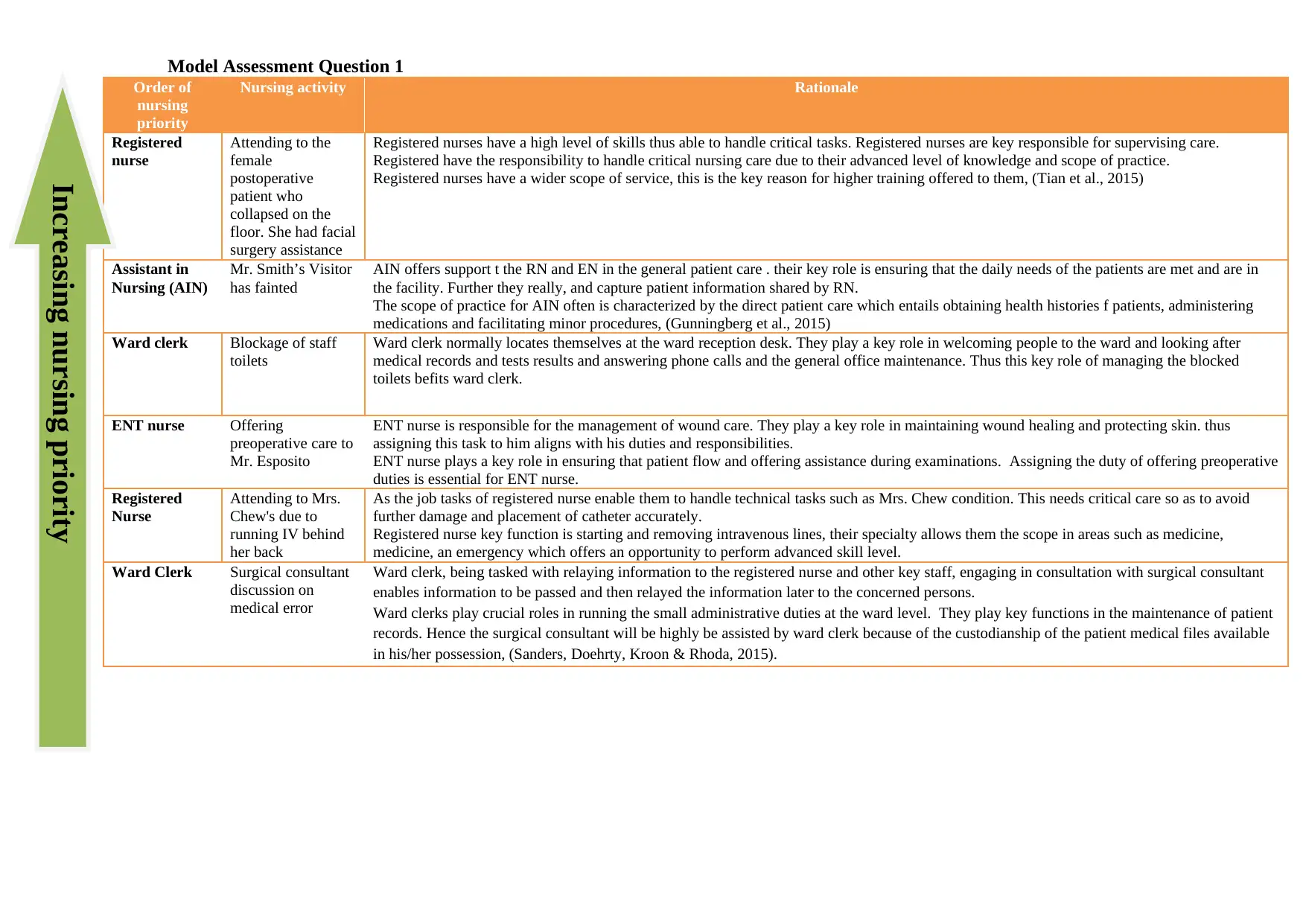
Model Assessment Question 1
Order of
nursing
priority
Nursing activity Rationale
Registered
nurse
Attending to the
female
postoperative
patient who
collapsed on the
floor. She had facial
surgery assistance
Registered nurses have a high level of skills thus able to handle critical tasks. Registered nurses are key responsible for supervising care.
Registered have the responsibility to handle critical nursing care due to their advanced level of knowledge and scope of practice.
Registered nurses have a wider scope of service, this is the key reason for higher training offered to them, (Tian et al., 2015)
Assistant in
Nursing (AIN)
Mr. Smith’s Visitor
has fainted
AIN offers support t the RN and EN in the general patient care . their key role is ensuring that the daily needs of the patients are met and are in
the facility. Further they really, and capture patient information shared by RN.
The scope of practice for AIN often is characterized by the direct patient care which entails obtaining health histories f patients, administering
medications and facilitating minor procedures, (Gunningberg et al., 2015)
Ward clerk Blockage of staff
toilets
Ward clerk normally locates themselves at the ward reception desk. They play a key role in welcoming people to the ward and looking after
medical records and tests results and answering phone calls and the general office maintenance. Thus this key role of managing the blocked
toilets befits ward clerk.
ENT nurse Offering
preoperative care to
Mr. Esposito
ENT nurse is responsible for the management of wound care. They play a key role in maintaining wound healing and protecting skin. thus
assigning this task to him aligns with his duties and responsibilities.
ENT nurse plays a key role in ensuring that patient flow and offering assistance during examinations. Assigning the duty of offering preoperative
duties is essential for ENT nurse.
Registered
Nurse
Attending to Mrs.
Chew's due to
running IV behind
her back
As the job tasks of registered nurse enable them to handle technical tasks such as Mrs. Chew condition. This needs critical care so as to avoid
further damage and placement of catheter accurately.
Registered nurse key function is starting and removing intravenous lines, their specialty allows them the scope in areas such as medicine,
medicine, an emergency which offers an opportunity to perform advanced skill level.
Ward Clerk Surgical consultant
discussion on
medical error
Ward clerk, being tasked with relaying information to the registered nurse and other key staff, engaging in consultation with surgical consultant
enables information to be passed and then relayed the information later to the concerned persons.
Ward clerks play crucial roles in running the small administrative duties at the ward level. They play key functions in the maintenance of patient
records. Hence the surgical consultant will be highly be assisted by ward clerk because of the custodianship of the patient medical files available
in his/her possession, (Sanders, Doehrty, Kroon & Rhoda, 2015).
Increasing nursing priority
Order of
nursing
priority
Nursing activity Rationale
Registered
nurse
Attending to the
female
postoperative
patient who
collapsed on the
floor. She had facial
surgery assistance
Registered nurses have a high level of skills thus able to handle critical tasks. Registered nurses are key responsible for supervising care.
Registered have the responsibility to handle critical nursing care due to their advanced level of knowledge and scope of practice.
Registered nurses have a wider scope of service, this is the key reason for higher training offered to them, (Tian et al., 2015)
Assistant in
Nursing (AIN)
Mr. Smith’s Visitor
has fainted
AIN offers support t the RN and EN in the general patient care . their key role is ensuring that the daily needs of the patients are met and are in
the facility. Further they really, and capture patient information shared by RN.
The scope of practice for AIN often is characterized by the direct patient care which entails obtaining health histories f patients, administering
medications and facilitating minor procedures, (Gunningberg et al., 2015)
Ward clerk Blockage of staff
toilets
Ward clerk normally locates themselves at the ward reception desk. They play a key role in welcoming people to the ward and looking after
medical records and tests results and answering phone calls and the general office maintenance. Thus this key role of managing the blocked
toilets befits ward clerk.
ENT nurse Offering
preoperative care to
Mr. Esposito
ENT nurse is responsible for the management of wound care. They play a key role in maintaining wound healing and protecting skin. thus
assigning this task to him aligns with his duties and responsibilities.
ENT nurse plays a key role in ensuring that patient flow and offering assistance during examinations. Assigning the duty of offering preoperative
duties is essential for ENT nurse.
Registered
Nurse
Attending to Mrs.
Chew's due to
running IV behind
her back
As the job tasks of registered nurse enable them to handle technical tasks such as Mrs. Chew condition. This needs critical care so as to avoid
further damage and placement of catheter accurately.
Registered nurse key function is starting and removing intravenous lines, their specialty allows them the scope in areas such as medicine,
medicine, an emergency which offers an opportunity to perform advanced skill level.
Ward Clerk Surgical consultant
discussion on
medical error
Ward clerk, being tasked with relaying information to the registered nurse and other key staff, engaging in consultation with surgical consultant
enables information to be passed and then relayed the information later to the concerned persons.
Ward clerks play crucial roles in running the small administrative duties at the ward level. They play key functions in the maintenance of patient
records. Hence the surgical consultant will be highly be assisted by ward clerk because of the custodianship of the patient medical files available
in his/her possession, (Sanders, Doehrty, Kroon & Rhoda, 2015).
Increasing nursing priority
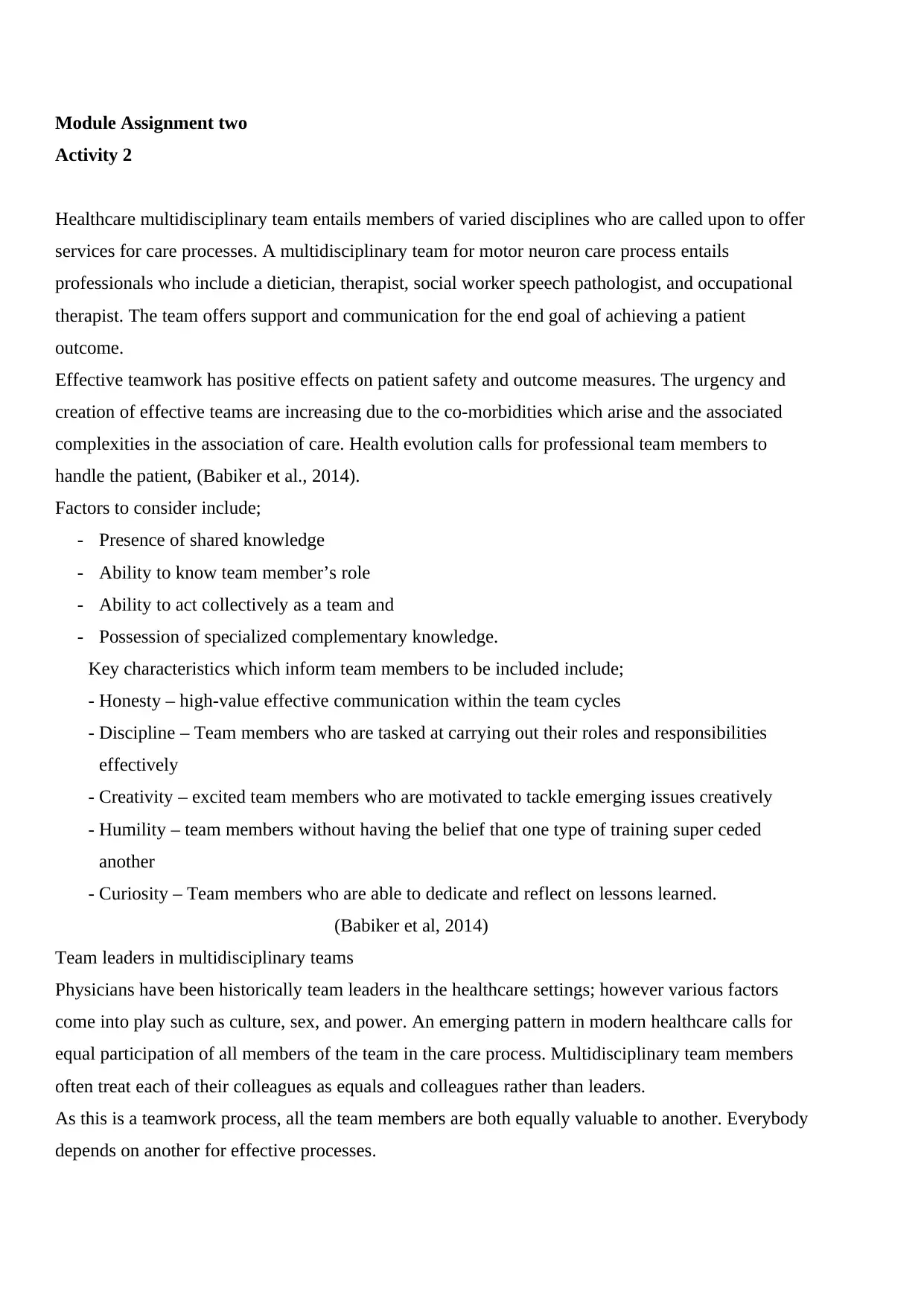
Module Assignment two
Activity 2
Healthcare multidisciplinary team entails members of varied disciplines who are called upon to offer
services for care processes. A multidisciplinary team for motor neuron care process entails
professionals who include a dietician, therapist, social worker speech pathologist, and occupational
therapist. The team offers support and communication for the end goal of achieving a patient
outcome.
Effective teamwork has positive effects on patient safety and outcome measures. The urgency and
creation of effective teams are increasing due to the co-morbidities which arise and the associated
complexities in the association of care. Health evolution calls for professional team members to
handle the patient, (Babiker et al., 2014).
Factors to consider include;
- Presence of shared knowledge
- Ability to know team member’s role
- Ability to act collectively as a team and
- Possession of specialized complementary knowledge.
Key characteristics which inform team members to be included include;
- Honesty – high-value effective communication within the team cycles
- Discipline – Team members who are tasked at carrying out their roles and responsibilities
effectively
- Creativity – excited team members who are motivated to tackle emerging issues creatively
- Humility – team members without having the belief that one type of training super ceded
another
- Curiosity – Team members who are able to dedicate and reflect on lessons learned.
(Babiker et al, 2014)
Team leaders in multidisciplinary teams
Physicians have been historically team leaders in the healthcare settings; however various factors
come into play such as culture, sex, and power. An emerging pattern in modern healthcare calls for
equal participation of all members of the team in the care process. Multidisciplinary team members
often treat each of their colleagues as equals and colleagues rather than leaders.
As this is a teamwork process, all the team members are both equally valuable to another. Everybody
depends on another for effective processes.
Activity 2
Healthcare multidisciplinary team entails members of varied disciplines who are called upon to offer
services for care processes. A multidisciplinary team for motor neuron care process entails
professionals who include a dietician, therapist, social worker speech pathologist, and occupational
therapist. The team offers support and communication for the end goal of achieving a patient
outcome.
Effective teamwork has positive effects on patient safety and outcome measures. The urgency and
creation of effective teams are increasing due to the co-morbidities which arise and the associated
complexities in the association of care. Health evolution calls for professional team members to
handle the patient, (Babiker et al., 2014).
Factors to consider include;
- Presence of shared knowledge
- Ability to know team member’s role
- Ability to act collectively as a team and
- Possession of specialized complementary knowledge.
Key characteristics which inform team members to be included include;
- Honesty – high-value effective communication within the team cycles
- Discipline – Team members who are tasked at carrying out their roles and responsibilities
effectively
- Creativity – excited team members who are motivated to tackle emerging issues creatively
- Humility – team members without having the belief that one type of training super ceded
another
- Curiosity – Team members who are able to dedicate and reflect on lessons learned.
(Babiker et al, 2014)
Team leaders in multidisciplinary teams
Physicians have been historically team leaders in the healthcare settings; however various factors
come into play such as culture, sex, and power. An emerging pattern in modern healthcare calls for
equal participation of all members of the team in the care process. Multidisciplinary team members
often treat each of their colleagues as equals and colleagues rather than leaders.
As this is a teamwork process, all the team members are both equally valuable to another. Everybody
depends on another for effective processes.
⊘ This is a preview!⊘
Do you want full access?
Subscribe today to unlock all pages.

Trusted by 1+ million students worldwide
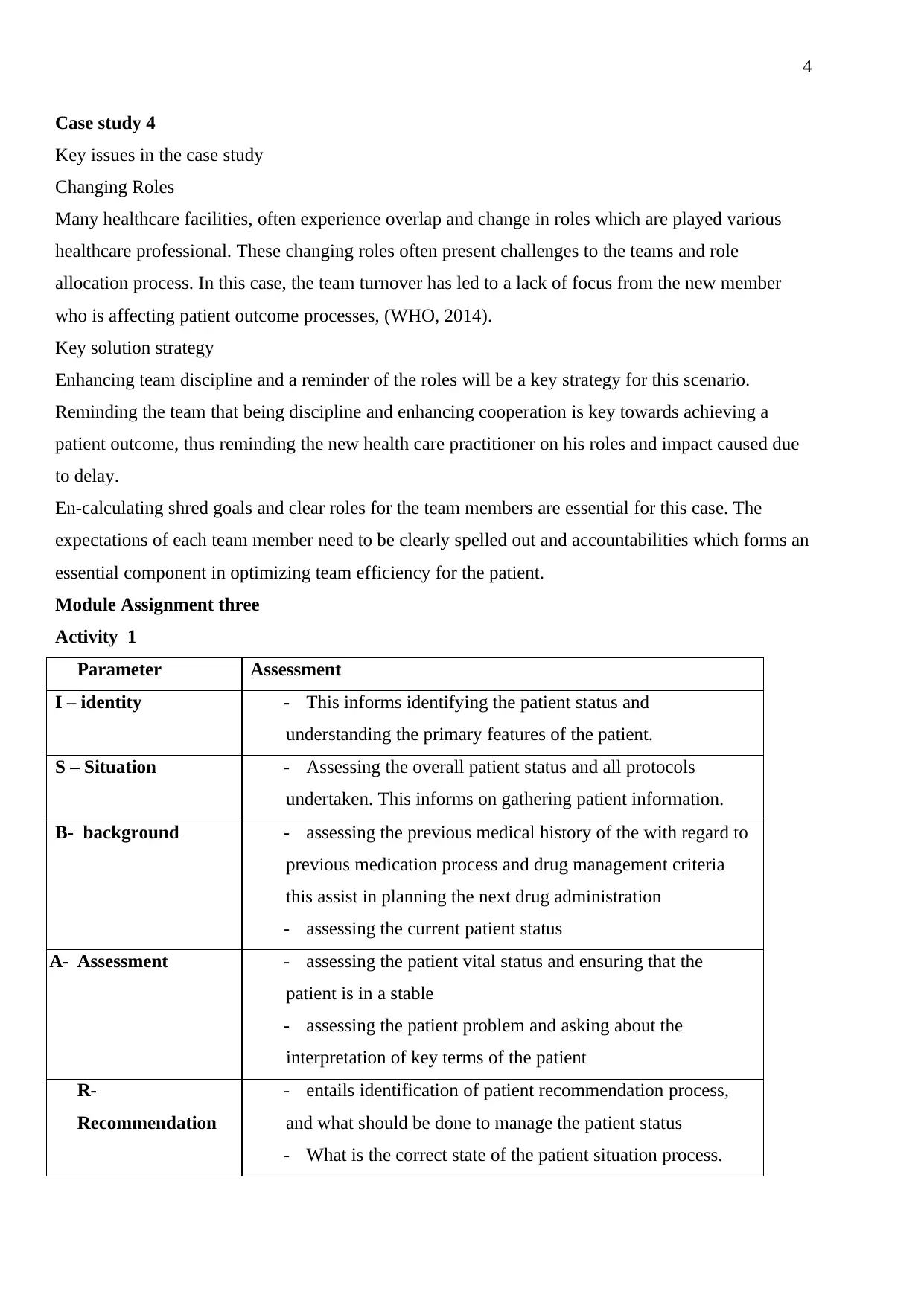
4
Case study 4
Key issues in the case study
Changing Roles
Many healthcare facilities, often experience overlap and change in roles which are played various
healthcare professional. These changing roles often present challenges to the teams and role
allocation process. In this case, the team turnover has led to a lack of focus from the new member
who is affecting patient outcome processes, (WHO, 2014).
Key solution strategy
Enhancing team discipline and a reminder of the roles will be a key strategy for this scenario.
Reminding the team that being discipline and enhancing cooperation is key towards achieving a
patient outcome, thus reminding the new health care practitioner on his roles and impact caused due
to delay.
En-calculating shred goals and clear roles for the team members are essential for this case. The
expectations of each team member need to be clearly spelled out and accountabilities which forms an
essential component in optimizing team efficiency for the patient.
Module Assignment three
Activity 1
Parameter Assessment
I – identity - This informs identifying the patient status and
understanding the primary features of the patient.
S – Situation - Assessing the overall patient status and all protocols
undertaken. This informs on gathering patient information.
B- background - assessing the previous medical history of the with regard to
previous medication process and drug management criteria
this assist in planning the next drug administration
- assessing the current patient status
A- Assessment - assessing the patient vital status and ensuring that the
patient is in a stable
- assessing the patient problem and asking about the
interpretation of key terms of the patient
R-
Recommendation
- entails identification of patient recommendation process,
and what should be done to manage the patient status
- What is the correct state of the patient situation process.
Case study 4
Key issues in the case study
Changing Roles
Many healthcare facilities, often experience overlap and change in roles which are played various
healthcare professional. These changing roles often present challenges to the teams and role
allocation process. In this case, the team turnover has led to a lack of focus from the new member
who is affecting patient outcome processes, (WHO, 2014).
Key solution strategy
Enhancing team discipline and a reminder of the roles will be a key strategy for this scenario.
Reminding the team that being discipline and enhancing cooperation is key towards achieving a
patient outcome, thus reminding the new health care practitioner on his roles and impact caused due
to delay.
En-calculating shred goals and clear roles for the team members are essential for this case. The
expectations of each team member need to be clearly spelled out and accountabilities which forms an
essential component in optimizing team efficiency for the patient.
Module Assignment three
Activity 1
Parameter Assessment
I – identity - This informs identifying the patient status and
understanding the primary features of the patient.
S – Situation - Assessing the overall patient status and all protocols
undertaken. This informs on gathering patient information.
B- background - assessing the previous medical history of the with regard to
previous medication process and drug management criteria
this assist in planning the next drug administration
- assessing the current patient status
A- Assessment - assessing the patient vital status and ensuring that the
patient is in a stable
- assessing the patient problem and asking about the
interpretation of key terms of the patient
R-
Recommendation
- entails identification of patient recommendation process,
and what should be done to manage the patient status
- What is the correct state of the patient situation process.
Paraphrase This Document
Need a fresh take? Get an instant paraphrase of this document with our AI Paraphraser
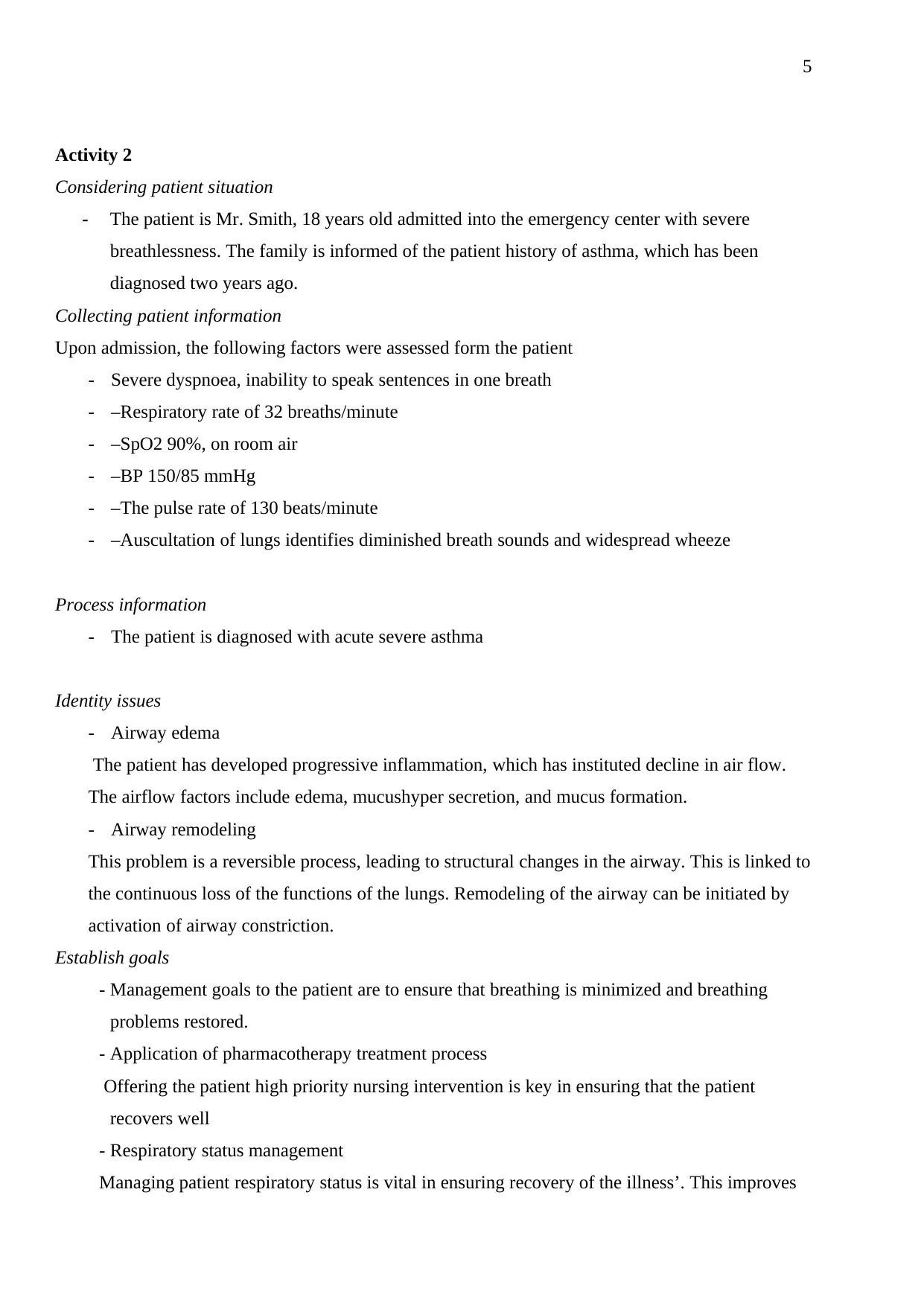
5
Activity 2
Considering patient situation
- The patient is Mr. Smith, 18 years old admitted into the emergency center with severe
breathlessness. The family is informed of the patient history of asthma, which has been
diagnosed two years ago.
Collecting patient information
Upon admission, the following factors were assessed form the patient
- Severe dyspnoea, inability to speak sentences in one breath
- –Respiratory rate of 32 breaths/minute
- –SpO2 90%, on room air
- –BP 150/85 mmHg
- –The pulse rate of 130 beats/minute
- –Auscultation of lungs identifies diminished breath sounds and widespread wheeze
Process information
- The patient is diagnosed with acute severe asthma
Identity issues
- Airway edema
The patient has developed progressive inflammation, which has instituted decline in air flow.
The airflow factors include edema, mucushyper secretion, and mucus formation.
- Airway remodeling
This problem is a reversible process, leading to structural changes in the airway. This is linked to
the continuous loss of the functions of the lungs. Remodeling of the airway can be initiated by
activation of airway constriction.
Establish goals
- Management goals to the patient are to ensure that breathing is minimized and breathing
problems restored.
- Application of pharmacotherapy treatment process
Offering the patient high priority nursing intervention is key in ensuring that the patient
recovers well
- Respiratory status management
Managing patient respiratory status is vital in ensuring recovery of the illness’. This improves
Activity 2
Considering patient situation
- The patient is Mr. Smith, 18 years old admitted into the emergency center with severe
breathlessness. The family is informed of the patient history of asthma, which has been
diagnosed two years ago.
Collecting patient information
Upon admission, the following factors were assessed form the patient
- Severe dyspnoea, inability to speak sentences in one breath
- –Respiratory rate of 32 breaths/minute
- –SpO2 90%, on room air
- –BP 150/85 mmHg
- –The pulse rate of 130 beats/minute
- –Auscultation of lungs identifies diminished breath sounds and widespread wheeze
Process information
- The patient is diagnosed with acute severe asthma
Identity issues
- Airway edema
The patient has developed progressive inflammation, which has instituted decline in air flow.
The airflow factors include edema, mucushyper secretion, and mucus formation.
- Airway remodeling
This problem is a reversible process, leading to structural changes in the airway. This is linked to
the continuous loss of the functions of the lungs. Remodeling of the airway can be initiated by
activation of airway constriction.
Establish goals
- Management goals to the patient are to ensure that breathing is minimized and breathing
problems restored.
- Application of pharmacotherapy treatment process
Offering the patient high priority nursing intervention is key in ensuring that the patient
recovers well
- Respiratory status management
Managing patient respiratory status is vital in ensuring recovery of the illness’. This improves
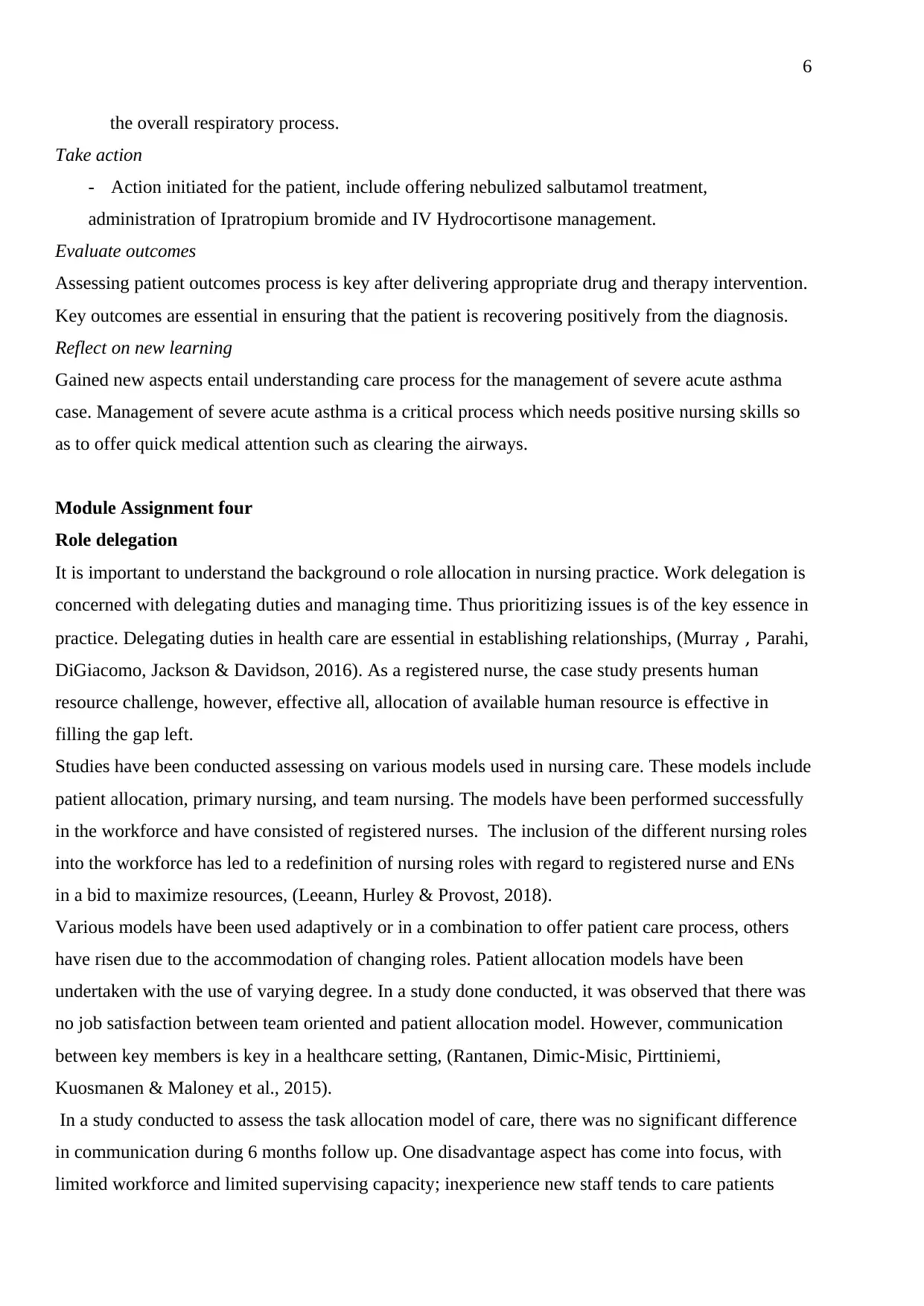
6
the overall respiratory process.
Take action
- Action initiated for the patient, include offering nebulized salbutamol treatment,
administration of Ipratropium bromide and IV Hydrocortisone management.
Evaluate outcomes
Assessing patient outcomes process is key after delivering appropriate drug and therapy intervention.
Key outcomes are essential in ensuring that the patient is recovering positively from the diagnosis.
Reflect on new learning
Gained new aspects entail understanding care process for the management of severe acute asthma
case. Management of severe acute asthma is a critical process which needs positive nursing skills so
as to offer quick medical attention such as clearing the airways.
Module Assignment four
Role delegation
It is important to understand the background o role allocation in nursing practice. Work delegation is
concerned with delegating duties and managing time. Thus prioritizing issues is of the key essence in
practice. Delegating duties in health care are essential in establishing relationships, (Murray , Parahi,
DiGiacomo, Jackson & Davidson, 2016). As a registered nurse, the case study presents human
resource challenge, however, effective all, allocation of available human resource is effective in
filling the gap left.
Studies have been conducted assessing on various models used in nursing care. These models include
patient allocation, primary nursing, and team nursing. The models have been performed successfully
in the workforce and have consisted of registered nurses. The inclusion of the different nursing roles
into the workforce has led to a redefinition of nursing roles with regard to registered nurse and ENs
in a bid to maximize resources, (Leeann, Hurley & Provost, 2018).
Various models have been used adaptively or in a combination to offer patient care process, others
have risen due to the accommodation of changing roles. Patient allocation models have been
undertaken with the use of varying degree. In a study done conducted, it was observed that there was
no job satisfaction between team oriented and patient allocation model. However, communication
between key members is key in a healthcare setting, (Rantanen, Dimic-Misic, Pirttiniemi,
Kuosmanen & Maloney et al., 2015).
In a study conducted to assess the task allocation model of care, there was no significant difference
in communication during 6 months follow up. One disadvantage aspect has come into focus, with
limited workforce and limited supervising capacity; inexperience new staff tends to care patients
the overall respiratory process.
Take action
- Action initiated for the patient, include offering nebulized salbutamol treatment,
administration of Ipratropium bromide and IV Hydrocortisone management.
Evaluate outcomes
Assessing patient outcomes process is key after delivering appropriate drug and therapy intervention.
Key outcomes are essential in ensuring that the patient is recovering positively from the diagnosis.
Reflect on new learning
Gained new aspects entail understanding care process for the management of severe acute asthma
case. Management of severe acute asthma is a critical process which needs positive nursing skills so
as to offer quick medical attention such as clearing the airways.
Module Assignment four
Role delegation
It is important to understand the background o role allocation in nursing practice. Work delegation is
concerned with delegating duties and managing time. Thus prioritizing issues is of the key essence in
practice. Delegating duties in health care are essential in establishing relationships, (Murray , Parahi,
DiGiacomo, Jackson & Davidson, 2016). As a registered nurse, the case study presents human
resource challenge, however, effective all, allocation of available human resource is effective in
filling the gap left.
Studies have been conducted assessing on various models used in nursing care. These models include
patient allocation, primary nursing, and team nursing. The models have been performed successfully
in the workforce and have consisted of registered nurses. The inclusion of the different nursing roles
into the workforce has led to a redefinition of nursing roles with regard to registered nurse and ENs
in a bid to maximize resources, (Leeann, Hurley & Provost, 2018).
Various models have been used adaptively or in a combination to offer patient care process, others
have risen due to the accommodation of changing roles. Patient allocation models have been
undertaken with the use of varying degree. In a study done conducted, it was observed that there was
no job satisfaction between team oriented and patient allocation model. However, communication
between key members is key in a healthcare setting, (Rantanen, Dimic-Misic, Pirttiniemi,
Kuosmanen & Maloney et al., 2015).
In a study conducted to assess the task allocation model of care, there was no significant difference
in communication during 6 months follow up. One disadvantage aspect has come into focus, with
limited workforce and limited supervising capacity; inexperience new staff tends to care patients
⊘ This is a preview!⊘
Do you want full access?
Subscribe today to unlock all pages.

Trusted by 1+ million students worldwide
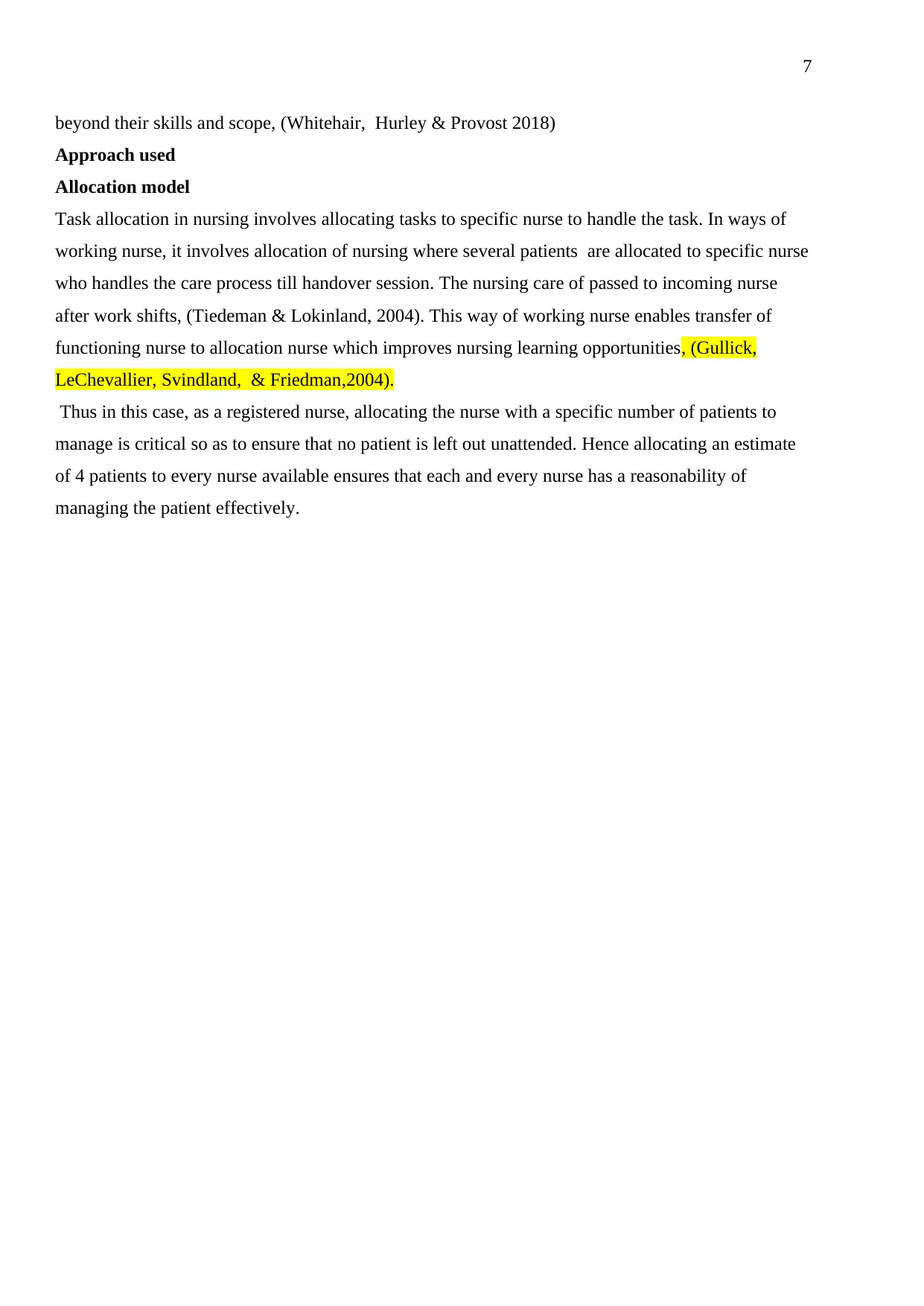
7
beyond their skills and scope, (Whitehair, Hurley & Provost 2018)
Approach used
Allocation model
Task allocation in nursing involves allocating tasks to specific nurse to handle the task. In ways of
working nurse, it involves allocation of nursing where several patients are allocated to specific nurse
who handles the care process till handover session. The nursing care of passed to incoming nurse
after work shifts, (Tiedeman & Lokinland, 2004). This way of working nurse enables transfer of
functioning nurse to allocation nurse which improves nursing learning opportunities, (Gullick,
LeChevallier, Svindland, & Friedman,2004).
Thus in this case, as a registered nurse, allocating the nurse with a specific number of patients to
manage is critical so as to ensure that no patient is left out unattended. Hence allocating an estimate
of 4 patients to every nurse available ensures that each and every nurse has a reasonability of
managing the patient effectively.
beyond their skills and scope, (Whitehair, Hurley & Provost 2018)
Approach used
Allocation model
Task allocation in nursing involves allocating tasks to specific nurse to handle the task. In ways of
working nurse, it involves allocation of nursing where several patients are allocated to specific nurse
who handles the care process till handover session. The nursing care of passed to incoming nurse
after work shifts, (Tiedeman & Lokinland, 2004). This way of working nurse enables transfer of
functioning nurse to allocation nurse which improves nursing learning opportunities, (Gullick,
LeChevallier, Svindland, & Friedman,2004).
Thus in this case, as a registered nurse, allocating the nurse with a specific number of patients to
manage is critical so as to ensure that no patient is left out unattended. Hence allocating an estimate
of 4 patients to every nurse available ensures that each and every nurse has a reasonability of
managing the patient effectively.
Paraphrase This Document
Need a fresh take? Get an instant paraphrase of this document with our AI Paraphraser
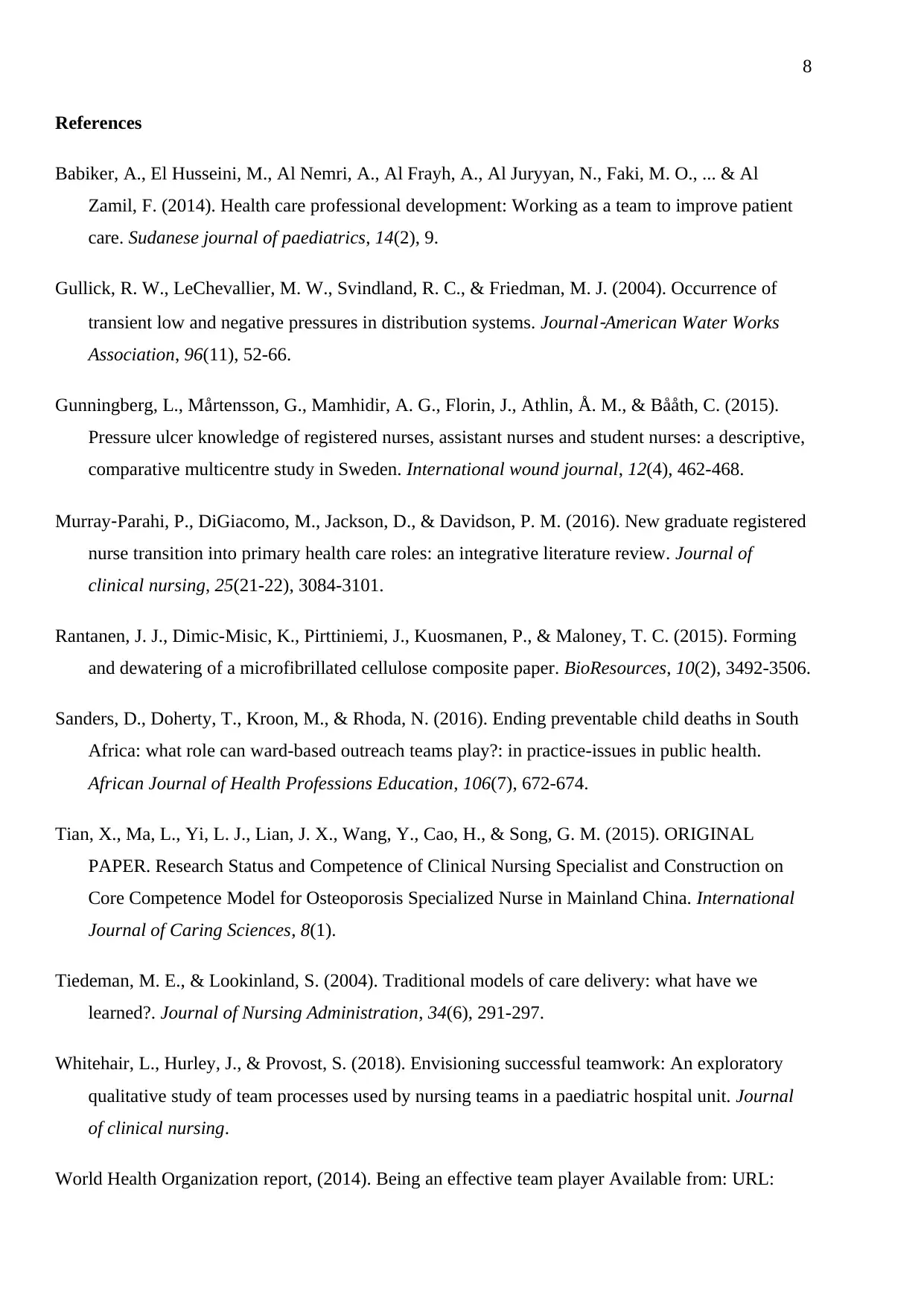
8
References
Babiker, A., El Husseini, M., Al Nemri, A., Al Frayh, A., Al Juryyan, N., Faki, M. O., ... & Al
Zamil, F. (2014). Health care professional development: Working as a team to improve patient
care. Sudanese journal of paediatrics, 14(2), 9.
Gullick, R. W., LeChevallier, M. W., Svindland, R. C., & Friedman, M. J. (2004). Occurrence of
transient low and negative pressures in distribution systems. Journal
‐American Water Works
Association, 96(11), 52-66.
Gunningberg, L., Mårtensson, G., Mamhidir, A. G., Florin, J., Athlin, Å. M., & Bååth, C. (2015).
Pressure ulcer knowledge of registered nurses, assistant nurses and student nurses: a descriptive,
comparative multicentre study in Sweden. International wound journal, 12(4), 462-468.
Murray‐Parahi, P., DiGiacomo, M., Jackson, D., & Davidson, P. M. (2016). New graduate registered
nurse transition into primary health care roles: an integrative literature review. Journal of
clinical nursing, 25(21-22), 3084-3101.
Rantanen, J. J., Dimic-Misic, K., Pirttiniemi, J., Kuosmanen, P., & Maloney, T. C. (2015). Forming
and dewatering of a microfibrillated cellulose composite paper. BioResources, 10(2), 3492-3506.
Sanders, D., Doherty, T., Kroon, M., & Rhoda, N. (2016). Ending preventable child deaths in South
Africa: what role can ward-based outreach teams play?: in practice-issues in public health.
African Journal of Health Professions Education, 106(7), 672-674.
Tian, X., Ma, L., Yi, L. J., Lian, J. X., Wang, Y., Cao, H., & Song, G. M. (2015). ORIGINAL
PAPER. Research Status and Competence of Clinical Nursing Specialist and Construction on
Core Competence Model for Osteoporosis Specialized Nurse in Mainland China. International
Journal of Caring Sciences, 8(1).
Tiedeman, M. E., & Lookinland, S. (2004). Traditional models of care delivery: what have we
learned?. Journal of Nursing Administration, 34(6), 291-297.
Whitehair, L., Hurley, J., & Provost, S. (2018). Envisioning successful teamwork: An exploratory
qualitative study of team processes used by nursing teams in a paediatric hospital unit. Journal
of clinical nursing.
World Health Organization report, (2014). Being an effective team player Available from: URL:
References
Babiker, A., El Husseini, M., Al Nemri, A., Al Frayh, A., Al Juryyan, N., Faki, M. O., ... & Al
Zamil, F. (2014). Health care professional development: Working as a team to improve patient
care. Sudanese journal of paediatrics, 14(2), 9.
Gullick, R. W., LeChevallier, M. W., Svindland, R. C., & Friedman, M. J. (2004). Occurrence of
transient low and negative pressures in distribution systems. Journal
‐American Water Works
Association, 96(11), 52-66.
Gunningberg, L., Mårtensson, G., Mamhidir, A. G., Florin, J., Athlin, Å. M., & Bååth, C. (2015).
Pressure ulcer knowledge of registered nurses, assistant nurses and student nurses: a descriptive,
comparative multicentre study in Sweden. International wound journal, 12(4), 462-468.
Murray‐Parahi, P., DiGiacomo, M., Jackson, D., & Davidson, P. M. (2016). New graduate registered
nurse transition into primary health care roles: an integrative literature review. Journal of
clinical nursing, 25(21-22), 3084-3101.
Rantanen, J. J., Dimic-Misic, K., Pirttiniemi, J., Kuosmanen, P., & Maloney, T. C. (2015). Forming
and dewatering of a microfibrillated cellulose composite paper. BioResources, 10(2), 3492-3506.
Sanders, D., Doherty, T., Kroon, M., & Rhoda, N. (2016). Ending preventable child deaths in South
Africa: what role can ward-based outreach teams play?: in practice-issues in public health.
African Journal of Health Professions Education, 106(7), 672-674.
Tian, X., Ma, L., Yi, L. J., Lian, J. X., Wang, Y., Cao, H., & Song, G. M. (2015). ORIGINAL
PAPER. Research Status and Competence of Clinical Nursing Specialist and Construction on
Core Competence Model for Osteoporosis Specialized Nurse in Mainland China. International
Journal of Caring Sciences, 8(1).
Tiedeman, M. E., & Lookinland, S. (2004). Traditional models of care delivery: what have we
learned?. Journal of Nursing Administration, 34(6), 291-297.
Whitehair, L., Hurley, J., & Provost, S. (2018). Envisioning successful teamwork: An exploratory
qualitative study of team processes used by nursing teams in a paediatric hospital unit. Journal
of clinical nursing.
World Health Organization report, (2014). Being an effective team player Available from: URL:

9
http://www.who.int/patientsafety/education/curriculum/who_mc_topic-4.pdf Accessed 2sept
2018. [Ref list]
http://www.who.int/patientsafety/education/curriculum/who_mc_topic-4.pdf Accessed 2sept
2018. [Ref list]
⊘ This is a preview!⊘
Do you want full access?
Subscribe today to unlock all pages.

Trusted by 1+ million students worldwide
1 out of 9
Related Documents
Your All-in-One AI-Powered Toolkit for Academic Success.
+13062052269
info@desklib.com
Available 24*7 on WhatsApp / Email
![[object Object]](/_next/static/media/star-bottom.7253800d.svg)
Unlock your academic potential
Copyright © 2020–2025 A2Z Services. All Rights Reserved. Developed and managed by ZUCOL.





